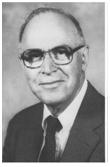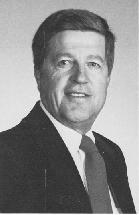1988 Honorary Life Member Selections
 ARTHUR KELMAN
ARTHUR KELMAN
Art Kelman was born December 18, 1918, in Providence, Rhode Island. He served in the U.S. Army Signal Corps from 1942 to 1945. He was a member of the North Carolina State University faculty from 1949 to 1965, and was named the William Neal Reynolds Distinguished Professor at that institution in 1961. His studies at North Carolina concentrated on bacterial diseases of plants, especially Pseudomonas solanacearum which caused the devastating Granville wilt of tobacco disease. In potato circles, this organism is known to cause the brown rot disease and is the limiting production factor in some warm climate regions. A major contribution was the development of a differential culture medium that distinguished virulent and a virulent bacterial colonies.
In 1965, Art Kelman accepted the position of Chairman of the Department of Plant Pathology, University of Wisconsin-Madison. In recognition of his outstanding leadership, he was named the L.R. Jones Distinguished Professor of Plant Pathology in 1975 and a WARF Distinguished Research Professor in 1984. He has been an effective, stimulating teacher and, in 1987, he was awarded the University of Wisconsin Distinguished Teaching Award and the College of Agricultural and Life Sciences Excellence in Teaching Award.
At Wisconsin, Art Kelman has maintained an active research program in phytobacteriology and has carried responsibility for postharvest disease problems. For the past 17 years, he has been particularly interested in the soft rot erwinias, especially as they affect potatoes. He has been instrumental in the development of selective media and serological techniques for the detection of Erwinia spp. in soil, insects and potatoes. Ecological and epidemiological studies with colleagues and students have led to control measures that are now saving the potato industry millions of dollars annually, e.g., studies on the relationships between bruising, moisture, oxygen potential and bacterial load and the development of a mist chamber method to estimate the soft rot potential of tuber lots have had a direct impact on the industry. More recently, studies on the role of calcium in soft rot susceptibility and internal brown spot of potatoes have had a significant industry impact.
Art Kelman has a remarkable record of service. He has been President of the American Phytopathological Society and the International Society of Plant Pathology. In 1976, he was elected to the National Academy of Sciences and was elected to its governing council in 1986. Perhaps the most remarkable feature that distinguished Art Kelman is that he is at home with a grower in the field, a scientist in the laboratory, or a politician in the public eye.
I am honored and pleased to present Arthur Kelman for Honorary Life Membership in The Potato Association of America.
Steven A. Slack, Nominator
 ROBERT E. THORNTON
ROBERT E. THORNTON
Robert E. Thornton was born in Twin Falls, Idaho, March 29, 1933. He graduated from Eden High School in 1951, obtained a B.S. degree in General Agriculture in 1955 and an M.S. degree in Horticulture in 1957 from the University of Idaho. He became Extension Horticulturist for Washington State University in 1967. During that time he worked towards and completed his Ph.D. in 1972, and in 1978 he attained the rank of full professor.
From 1957 to 1960 he was employed by the University of Idaho, but his career as a potato specialist began in 1960 when he was employed by the J.R. Simplot Company to do research on raw potato quality as influenced by cultural practices and storage. His knowledge of potato production and processing problems was greatly increased between 1962 and 1966 while serving as the University of Idaho’s Area Extension Potato and Onion Specialist for the 10 southwest counties of Idaho. For the past 21 years, he has served the potato industry of the State of Washington as Extension Horticulturist for vegetable crops, but most of his energies were devoted to potatoes. During this time Washington State has become the area where the highest per acre yields in the world are produced. He has supervised and cosponsored studies on potato harvesting and handling, potato seed quality and planter spacing and has been involved with various other studies on potatoes. Since 1982 he has directed the cultivar testing program for the State of Washington. During his tenure he has been chairperson for the Washington State Potato Conference and Trade Fair which has completed its 27th annual meeting. He also served as acting chairperson for the Department of Horticulture/Landscape Architecture at Washington State University for about one year.
Bob has achieved an extensive knowledge of potatoes and their problems worldwide. He has traveled to the International Potato Research and Extension Center at Lima, Peru, spent a sabbatical leave in Scotland and visited production areas in Pakistan. He has participated on numerous national potato organizational committees because of his comprehensive knowledge of Washington and the U.S. potato industry. His services to The PAA have been extensive, having served on numerous committees and also as its president. Bob was a founding member of the The PAA Extension Committee’s anti-bruising campaign.
Bob has authored extension and research publications, is coauthor of APJ “Commercial Potato Production in North America,” coauthor of “Understanding the Potato” published by Washington State University and coauthor of “Physiological Disorders of Potato Tubers in Potato Physiology” edited by Paul H. Li.
Bob married his wife, Carol, in 1953. They have two daughters and three sons. The three sons are also involved in the potato industry. Much of the credit for these accomplishments must be given to Carol who has supported Bob throughout his career. His hobbies include racquetball, camping and traveling.
Mark Martin, Nominator